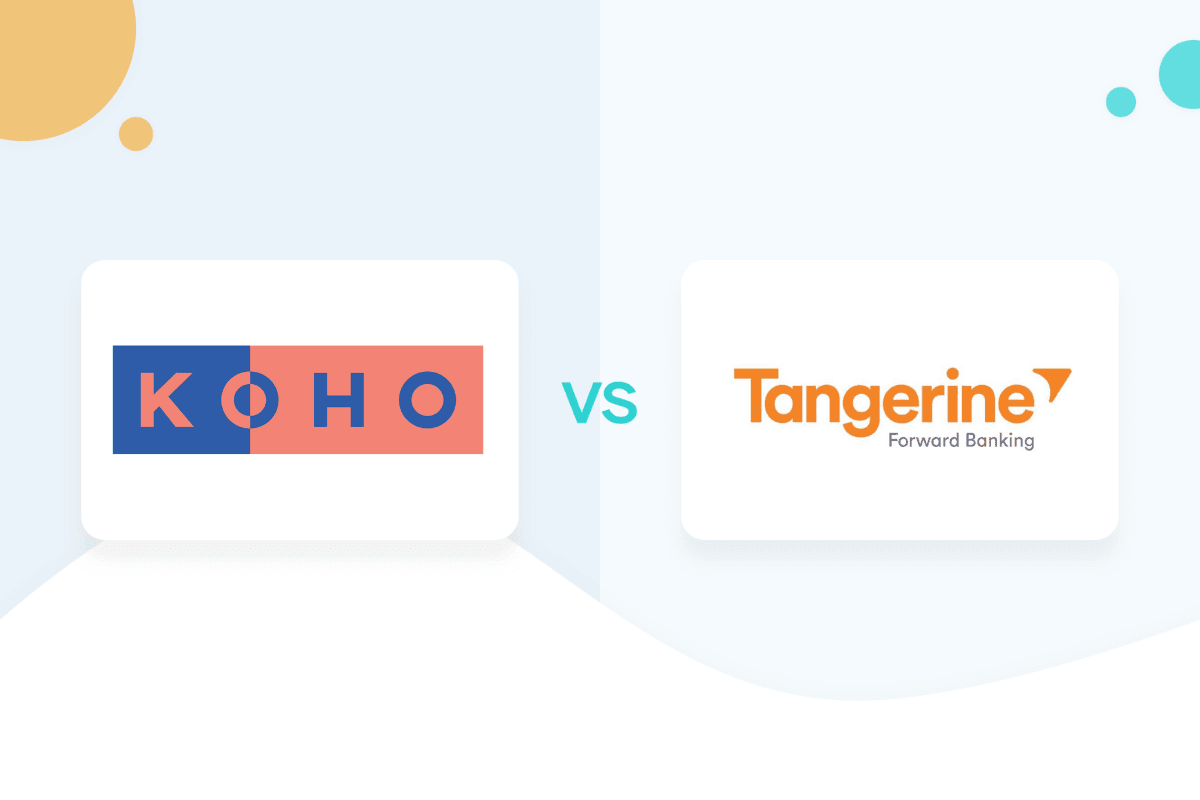KOHO VS Tangerine: Which One is Best for You?
By Maude Gauthier | Published on 16 Apr 2024

Tangerine isn’t usually the first name that comes to mind when one thinks of KOHO competitors. KOHO is mainly known for offering a prepaid card, whereas Tangerine is mostly popular for its high interest savings accounts. However, it does offer a Visa debit card that can be used in a similar way as a prepaid card. Moreover, the two companies have a lot more in common. They’re both Canadian organizations with thousands of users. But, which is the better option? If you’re looking for a prepaid card to help you keep control of your money, KOHO is definitely your best option. However, if you are planning on withdrawing money often at ATMs or fully replace your existing bank, go with Tangerine.
Introduction to KOHO and Tangerine
[Offer productType=“CreditCard” api_id=“637cf8206bbb7962c19ae225″]Founded in 2014, KOHO is marketed as a banking alternative and offers a variety of banking services. However, since it isn’t a bank, the organization has joined hands with Peoples Trust to be able to offer these products and services. Their prepaid card is very easy to get. Moreover, you can improve your credit with KOHO’s Credit Building service which costs $5-$10 per month.
Unlike KOHO, Tangerine is a digital bank that is also a subsidiary of Scotiabank. Being associated with such a big name makes Tangerine reliable. It offers a variety of banking services including mortgages, investment products, no-fee accounts, and debit and credit cards. Founded in 1997 and originally known as ING Direct Canada, Tangerine was acquired by Scotiabank in 2012. Tangerine makes it possible for you to use Scotibank ATMs for free.
Saving with KOHO versus Tangerine
Canadians really embraced KOHO’s savings features since very few prepaid card providers pay interest on deposits AND offer budgeting and savings tools. KOHO pays 5% interest on your balance. This might not sound much but it’s higher than what most traditional banks in Canada offer their clients. KOHO pays interest on everything that enters or leaves your account.
Just like KOHO, a Tangerine’s Savings Account also pays interest on deposits but it is only at 0.70% on a regular savings account. The interest rate pales in comparison! Tangerine gives users a variety of savings accounts to choose from including:
- A regular savings account
- Retirement Savings Plan (RSP) Savings Account
- Tax-Free Savings Account (TFSA)
- Retirement Income Fund (RIF) Savings Account
- US Dollar (USD) Savings Account
Interest is calculated daily and earned profit is available for use or withdrawal at the end of the month. Tangerine is able to offer these different type of accounts because it is a bank, while KOHO is a fintech.
KOHO is the obvious winner here as it pays more money, but there is a drawback since it has fewer account types. Go for Tangerine if you want special accounts such as a USD account or retirement account as KOHO doesn’t offer these.
KOHO Prepaid Card versus Tangerine Visa Debit
The Essential plan offers 1% cash back on groceries, transportation, eating & drinking, plus up to 50% extra cash back from select merchants. This plan costs $4/month. Also, the company offers free ATM withdrawals but you should expect to spend $2 to $3 per withdrawal since KOHO doesn’t have its own ATMs.
For $9/month or $84/year, KOHO Extra gives you 1% cash back on groceries, billings & services, eating & drinking, and 0.25% cash back on all other purchases. You also get 1 free international withdrawal per month and no foreign exchange fees. For $19/month, you get Everything, which means 2% cash back on groceries, billings & services, eating & drinking, and 0.5% on all other purchases. With these plans, you may also earn extra cash back at partner stores.
While Tangerine also offers credit cards, we’re mainly going to focus on Tangerine Visa Debit in this review as it is the closest to what KOHO offers. Tangerine charges no monthly fee. Moreover, it offers unlimited free transactions. But, there may be some other charges such as Non-Sufficient Fund fee that goes as high as $45. This fee can be avoided by activating the overdraft protection feature.
| KOHO Essential | Tangerine Visa Debit Card | |
| Monthly charges | $0-$4 | $0 |
| Foreign exchange fees | 1.5% | 2.5% |
| NSF Fee | n/a | $45 |
| ATM Fee | $3 | $0 when using Scotiabank |
The card works both online and offline and can be used to even pay bills. It can be a great option for users who do not want the hassle of a credit card and wish to enjoy some ease. The card works nationally and internationally at all stores that accept Visa. You can also order cheques if you need them, which is not possible with KOHO.
KOHO versus Tangerine: which has the better app?
Both KOHO and Tangerine allow users to manage their accounts through mobile apps that work on both iOS and Android devices. Both mobile apps work well and are easy to use. Also, they take little space. Still, it can be a little hard to compare the two.
According to the company, the app is designed to help you keep control of your finances and stick to your budget. The app has some impressive features. KOHO has a RoundUp feature that automatically puts change into your savings that you can use in the future. It works by rounding off the amount. For example, $9.5 to $10. You will pay $9.5 to the merchant and $0.5 will go to your savings account. You can decide on the round off pointer.
Moreover, you can even create Savings Goals through the app and keep a tab on how close you are to your goal. Other than this, the app will help you keep an eye on your transactions and identify issues. Plus, it can even be used to pay bills and manage deposits.
On the other hand, the Tangerine mobile app is a powerhouse. With this app, you will be able to locate nearby ATMs, receive notifications, review transactions, transfer money, and manage your account. The app even lets users buy and sell Tangerine Investment Funds and deposit cheques.
Just like KOHO, Tangerine also offers some management tools and insights to help keep an eye on your budgeting. For instance, the Left to Spend tool uses information from your accounts, along with details you provide about your income and expenses, to help you make smarter decisions.
Moreover, both apps support a variety of digital wallets such as Apple Pay and Google Pay. All in all, both these apps are great and work well.
KOHO VS Tangerine: Which one should I choose?
Let’s end this KOHO versus Tangerine battle by picking the better option. We believe the right choice depends on factors such as your financial situation and requirements. Tangerine can be a great option for people who want full banking services at affordable rates.
On the other hand, KOHO hits the bull’s eye with its prepaid card that will not impact your credit score because there is no hard credit check when you apply and that can be great for people who want to be in better control of their finances. But it doesn’t come with all the features that Tangerine offers.
